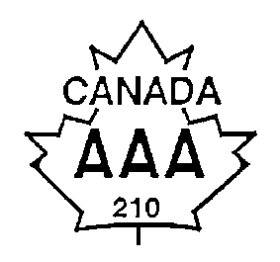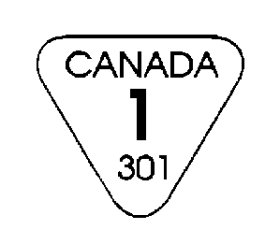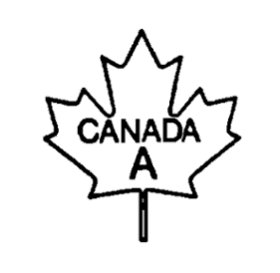Canadian Grade Compendium: Volume 1 – Ovine Carcasses and Poultry Carcasses
On this page
- Interpretation
- Part 1 General
-
Part 2 Ovine Carcass Grade Requirements
- Grades and Grade Names
- General
- Grade Requirements for Canada AAA
- Grade Requirements for Canada C1
- Grade Requirements for Canada C2
- Grade Requirements for Canada D1
- Grade Requirements for Canada D4
- Schedule 1 – Maturity Characteristics for Lamb Carcasses
- Schedule 2 – Maturity Characteristics for Mutton Carcasses
- Schedule 3 – Ovine Carcass Grade Stamp
- Schedule 4 – Lamb Carcass Yield Stamp
- Part 3 Poultry Carcass Grade Requirements
Interpretation
1. The following definitions apply in this Volume.
"break joint" means the metacarpo-phalangeal joint of the foreleg of a lamb carcass. (articulation dentelée)
"lamb carcass" means an ovine carcass that has the maturity characteristics set out in Schedule 1 – Maturity Characteristics for Lamb Carcasses. (carcasse d'agneau)
"mutton carcass" means an ovine carcass that has the maturity characteristics set out in Schedule 2 – Maturity Characteristics for Mutton Carcasses. (carcasse de mouton)
"ovine carcass" means the carcass of a slaughtered ovine animal that has a carcass weight of 13.5 kg or more and that has had the following removed, namely,
- (a) the pelt,
- (b) that portion of the head and neck forward of the first cervical vertebra,
- (c) that portion of the hind leg below the metatarso-phalangeal (ankle) joint,
- (d) the respiratory, digestive, reproductive and urinary systems and the thoracic and abdominal organs,
- (e) the membranous portion of the diaphragm,
- (f) the heart fat and scrotal or udder fat,
- (g) the tail posterior to the third coccygeal vertebra, and
- (h) any portion of the carcass the removal of which is required for pathological reasons. (carcasse d'ovin)
"spool joint" means the metacarpo-phalangeal joint of the foreleg of a mutton carcass. (articulation cannelée)
"yield" means, in respect of a lamb carcass, the estimated percentage of lean meat in the lamb carcass derived from the primal cuts thereof, as determined by a grader. (rendement)
"yield class" means, in respect of a lamb carcass, the yield class determined in accordance with subsection 4(6). (catégorie de rendement)
"yield stamp" means, in respect of a lamb carcass, the mark that is made on the lamb carcass by a grade stamp applicator that shows the yield class of the carcass and the grader's code and is in the outline of a triangle, as set out in Schedule 4 – Lamb Carcass Yield Stamp. (cachet de rendement)
Part 1 General
2. Ink that is used to label an ovine carcass or a poultry carcass must be
- (a) indelible;
- (b) fast drying; and
- (c) colour and chemically consistent.
Part 2 Ovine Carcass Grade Requirements
Grades and Grade Names
3. There are five grades of ovine carcasses with the grade names Canada AAA, Canada C1, Canada C2, Canada D1 and Canada D4 (see Volume 9, Import Grade Requirements for grade names used for imported ovine carcasses).
General
4. (1) A grader, when requested by the licence holder, or the licence holder under the direct supervision of a grader, must mark the ovine carcass with a grade stamp, illustrated in Schedule 3 – Ovine Carcass Grade Stamp to this Part, in red ink, on the leg and foresaddle, on both sides of the lamb carcass.
(2) If requested by the licence holder, a lamb carcass that meets the requirements for grade Canada AAA must be marked with a yield stamp Canada 1, Canada 2, Canada 3 or Canada 4, in accordance with the yield class determined in subsection (6),
(3) The yield stamp, referred to in subsection (2), illustrated in Schedule 4 – Lamb Carcass Yield Stamp to this Part as a triangle, must be applied by a grader, or by the licence holder under the direct supervision of a grader, in red ink, on the leg and foresaddle, on both sides of the lamb carcass.
(4) A inspector, or an employee of a licence holder, must determine the maturity of an ovine carcass
- (a) by examining its dentition; or
- (b) by determining the presence of a break joint or spool joint and examining the colour and distribution of blood deposits in the joint.
(5) A grader must determine the fat level of an ovine carcass by measuring the fat with a ruler over the twelfth rib and 11 cm off the midline of the ovine carcass.
(6) The yield class of a lamb carcass, determined by a grader, that is graded Canada AAA and that has a fat measurement set out in Column 1 of an item of the Table for Yield Class for Lamb Carcasses Graded Canada AAA is the yield class set out in Column 2 of that item.
| Item | Column 1 Fat Measurement (mm) |
Column 2 Yield Class |
|---|---|---|
| 1. | Less than 13 | Canada 1 |
| 2. | 13 to 18.9 | Canada 2 |
| 3. | 19 to 24.9 | Canada 3 |
| 4. | 25 or more | Canada 4 |
(7) A grader must determine the average musculature score of every lamb carcass by evaluating the musculature of each primal cut, by assigning a score ranging from a minimum of 1 to a maximum of 5 for the musculature of each primal cut, by determining the total musculature score for the primal cuts and by dividing the total musculature score by 3.
Grade Requirements for Canada AAA
5. An ovine carcass graded Canada AAA must have
- (a) the maturity characteristics set out in Schedule 1 – Maturity Characteristics for Lamb Carcasses to this Part;
- (b) a minimum musculature score of 2 for each primal cut and a minimum average musculature score of 2.6;
- (c) flank muscles that are pink to light red in colour;
- (d) a fat covering that
- (i) is firm and white or slightly tinged with a reddish or amber colour,
- (ii) is not less than 4 mm in thickness at the measurement site, and
- (iii) extends to provide at least a thin cover over the top of the shoulders, the back and the outside of the centre part of the legs; and
- (e) a minimum of traces of fat streakings on the inside flank muscles.
Grade Requirements for Canada C1
6. An ovine carcass graded Canada C1 must have
- (a) the maturity characteristics set out in Schedule 1 – Maturity Characteristics for Lamb Carcasses to this Part;
- (b) a minimum musculature score of 1 for each primal cut or a minimum average musculature score of less than 2.6;
- (c) flank muscles that are pink to light red in colour; and
- (d) a fat covering that
- (i) is firm and white or slightly tinged with a reddish or amber colour, and
- (ii) is less than 4 mm in thickness at the measurement site.
Grade Requirements for Canada C2
7. An ovine carcass graded Canada C2 must have the maturity characteristics set out in Schedule 1 – Maturity Characteristics for Lamb Carcasses to this Part and
- (a) flank muscles that are dark red in colour; or
- (b) a fat covering that is yellow in colour.
Grade Requirements for Canada D1
8. An ovine carcass graded Canada D1 must have
- (a) the maturity characteristics set out in Schedule 2 – Maturity Characteristics for Mutton Carcasses to this Part; and
- (b) a fat covering that is less than 13 mm in thickness at the measurement site.
Grade Requirements for Canada D4
9. An ovine carcass graded Canada D4 must have
- (a) the maturity characteristics set out in Schedule 2 – Maturity Characteristics for Mutton Carcasses to this Part; and
- (b) a fat covering that is 13 mm or more in thickness at the measurement site.
Schedule 1 – Maturity Characteristics for Lamb Carcasses
- Fewer than two permanent incisors;
or
- Two break joints or, in the case of a carcass with one break joint and one spool joint, the break joint has four intact and well-defined ridges with at least a slightly red and slightly damp surface.
- Ribs that are no more than slightly wide, tend to be rounded rather than flat and are reddish in colour.
An ovine carcass could contain two permanent incisors and still be considered a lamb, if items 2 and 3 above are met.
Schedule 2 – Maturity Characteristics for Mutton Carcasses
- Two or more permanent incisors.
- Two spool joints or, in the case of a carcass with one break joint and one spool joint, the break joint has a dry and mainly white surface.
- Ribs that are wide, flat and white.
Schedule 3 – Ovine Carcass Grade Stamp

Schedule 4 – Lamb Carcass Yield Stamp

Part 3 Poultry Carcass Grade Requirements
Grades and Grade Names
10. There are three grades of poultry carcasses with the grade names Canada A, Canada Utility and Canada C (see Volume 9, Import Grade Requirements for grade names used for imported poultry carcasses).
General
11. (1) A grader, or the licence holder under the direct supervision of a grader, must mark the poultry carcass with a grade stamp, illustrated in Schedule 5 – Poultry Carcass Grade Stamps to this Part, with the grade name being in white characters and the outline of the maple leaf being
- (a) red, if the poultry is graded Canada A,
- (b) blue, if the poultry is graded Canada Utility, and
- (c) brown, if the poultry is graded Canada C.
(2) Despite subsection (1), in the case of a poultry carcass that is not a prepackaged food and is in a container
- (a) the grade name may be shown in black characters within the outline of the maple leaf grade name,
- (b) the outline of the maple leaf grade name may be black or may be the same colour as the grade name required in subsection (1), and
- (c) the grade name is not required to be within the outline of a maple leaf.
Grade Requirements for Canada A
12. A poultry carcass graded Canada A must
- (a) in the case of a chicken, chicken capon, Rock Cornish hen, mature chicken, old rooster, young turkey and mature turkey, have not more than the wing tips and the tail removed from the carcass;
- (b) in the case of a young duck, mature duck, young goose, mature goose, young guinea and mature guinea, have not more than the wing tips and the flat wings removed from the carcass;
- (c) be not deformed except for a slightly crooked keel bone that does not interfere with the normal placement of the meat;
- (d) be moderately plump breasted on both sides of the keel bone at the anterior end, with a moderate tapering of flesh towards the posterior end, and the keel bone at the anterior end does not project more than 3 mm beyond the flesh;
- (e) in the case of poultry, other than a turkey, show evidence of fat cover on the breast, thighs and back;
- (f) in the case of a turkey, have deposits of fat in the main feather tract on each side of the breast as indicated by a pronounced thickening at the centre of each such area;
- (g) have no prominent discolourations exceeding
- (i) an area of 1.6 cm2 in the aggregate on the breast, and
- (ii) an area of 6.5 cm2 in the aggregate elsewhere on the carcass.
- (h) if the carcass weighs less than 5.5 kg, have skin on the breast that is not torn in excess of 6 mm in length and have no tears on the skin elsewhere on the carcass that exceed 2.5 cm in length in the aggregate;
- (i) if the carcass weighs 5.5 kg or more, have skin on the breast that is not torn in excess of 1.2 cm in length and have no tears on the skin elsewhere on the carcass that exceed 3.5 cm in length in the aggregate;
- (j) have no broken or dislocated bones; and
- (k) not have more than 3 cm of exposed flesh at the posterior end of the keel bone.
Grade Requirements for Canada Utility
13. (1) Subject to subsections (2) and (3), a poultry carcass graded Canada Utility must
- (a) not be missing more than
- (i) the wings,
- (ii) one leg including the thigh or both drumsticks,
- (iii) the tail,
- (iv) small areas of flesh, and
- (v) skin not exceeding an area equivalent to one half of the area of the breast;
- (b) if no flesh has been removed, have a breast that has sufficient fullness of flesh on both sides of the keel bone to prevent a sharp falling away of flesh from the anterior to the posterior end and the keel bone does not project more than 3 mm beyond the flesh;
- (c) have at least a minimum fat cover to prevent the flesh from appearing prominently through the skin;
- (d) have no prominent discolourations exceeding
- (i) an area of 6.5 cm2 in the aggregate on the breast, and
- (ii) an area of 8 cm2 in the aggregate elsewhere on the carcass.
- (e) have no dislocated bones other than in the wings or legs; and
- (f) have no broken bones.
(2) A poultry carcass must not be graded Canada Utility if
- (a) the wings or any part of them has been removed elsewhere than at a joint; and
- (b) only a part of the drumsticks has been removed.
(3) A poultry carcass must not be graded Canada Utility if it meets the requirements for the grade Canada A.
(4) Despite subsection (1), a mature chicken carcass may be graded Canada Utility if it
- (a) weighs less than 1.8 kg;
- (b) meets the requirements set out in paragraphs 14(1)(b) and (c); and
- (c) is trimmed in accordance with paragraph (1)(a).
Grade Requirements for Canada C
14. (1) Subject to subsection (2), a poultry carcass graded Canada C must
- (a) be the carcass of a mature chicken;
- (b) have a breast that has sufficient fullness of flesh on both sides of the keel bone to prevent an extremely sharp falling away of flesh from the anterior to the posterior end and the keel bone does not project more than 5 mm beyond the flesh; and
- (c) have no prominent discolourations exceeding an area of 14.5 cm2 in the aggregate.
(2) A mature chicken carcass must not be graded Canada C if it meets the requirements for the grade Canada A, or the grade Canada Utility.
Schedule 5 – Poultry Carcass Grade Stamps



- Date modified: